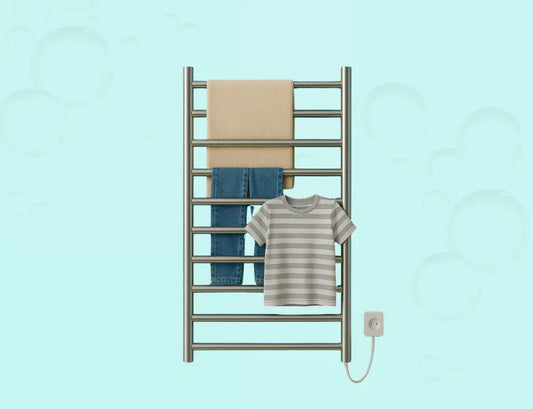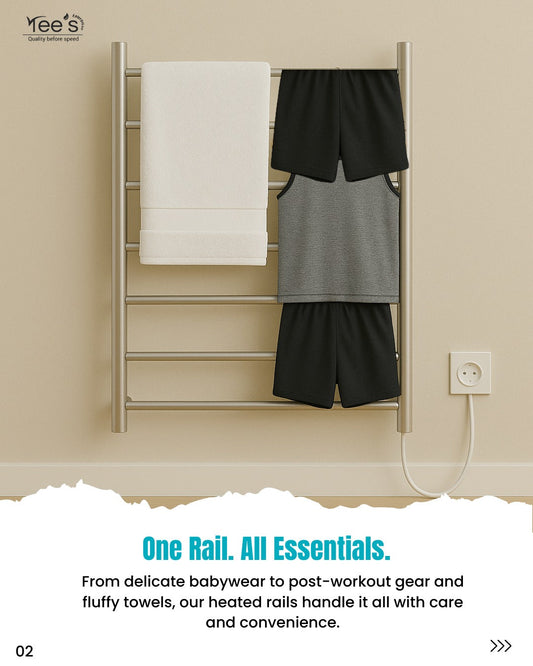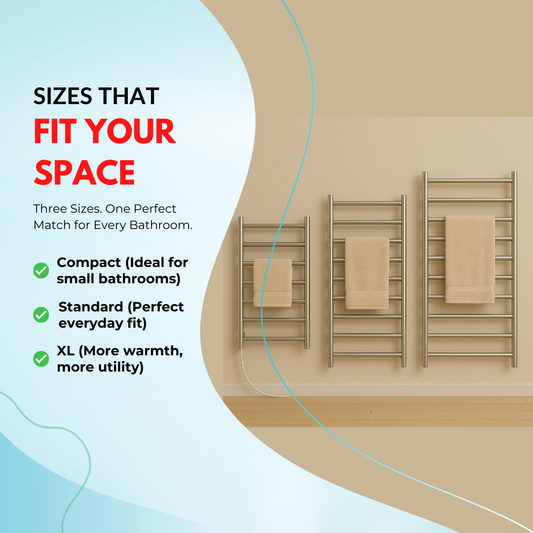Top 7 Reasons to Use Heated Clothes Rails in Indian Households
In most Indian households, drying clothes has always been a balancing act between available space, unpredictable weather, and time constraints.
Traditional methods like hanging clothes on balconies, terraces, or string lines across the living room are still common—but not always efficient, hygienic, or quick. Enter a modern solution: the heated clothes rail.
Now gaining popularity in metros and even semi-urban areas, heated clothes rail India models are making life significantly easier for families struggling with limited space or monsoon drying challenges. Whether you live in a compact apartment or a multi-floor bungalow, a heated clothes rail can completely transform your laundry routine.
In this blog, we explore the top 7 reasons to use heated clothes rails in Indian households, and how they stack up against traditional clothes drying rack India options.
1. Efficient Drying in All Seasons
India’s climate is diverse and often unpredictable. From the long monsoons in Kerala to chilly winters in North India, drying clothes outdoors can be unreliable.
A heated clothes rail offers year-round drying, regardless of weather. You no longer have to wait for sunlight or plan your laundry around the rain. Just switch it on, and your clothes begin drying immediately.
Bonus: It reduces your dependency on outdoor spaces, especially helpful for apartments or homes without balconies.
2. Ideal for Small Flats and Urban Living
Space constraints are a real issue in Indian cities like Mumbai, Delhi, and Bengaluru. Traditional clothes drying racks can take up floor space and make your home look messy.
Heated clothes rails are compact, often foldable, and sleek in design. You can use them in a bathroom, near a window, or even in your bedroom without them getting in the way. Some models are wall-mounted, saving even more space.
When choosing a clothes drying rack India option, consider going for a heated rail if you need space-efficiency without compromising on performance.
3. Quick Drying and Time-Saving
Let’s face it—nobody likes damp, semi-dry clothes hanging around the house for hours. With a heated rail, your clothes can dry in a fraction of the time compared to traditional racks.
Most heated clothes rails in India can dry lightweight items like t-shirts, towels, or innerwear in 2–4 hours. Heavier items like jeans or woollens take slightly longer but still dry significantly faster than air-drying indoors.
This is perfect for:
-
Working professionals
-
Students living in hostels
-
Families with children who generate frequent laundry
4. Reduces Musty Smell and Mold Growth
One of the most common complaints with indoor drying is that clothes develop a musty or damp odor, especially during the monsoon or in poorly ventilated homes.
Heated clothes rails reduce moisture in clothes quickly, lowering the risk of:
-
Mold and mildew growth
-
Allergens in fabric
-
Lingering odors in towels and innerwear
For Indian households where hygiene is a top priority, this makes a heated rail a healthier alternative to open-air indoor drying.
5. Gentle on Clothes, Unlike Tumble Dryers
While tumble dryers are effective, they can be harsh on delicate fabrics. In India, where clothes often include sarees, kurtas, and embellished garments, a gentler drying method is necessary.
Heated clothes rail India models work on low-temperature heating, meaning there’s no harsh spinning or over-drying. Clothes retain their shape, texture, and color.
It’s especially suitable for:
-
Cotton and linen garments
-
Delicate silks or wool blends
-
Kidswear and baby clothes
6. Energy Efficient and Eco-Friendly
Compared to running a full-size electric dryer, a heated clothes rail uses significantly less electricity. Most models consume between 100–200 watts per hour, making them energy efficient.
Considering India’s rising electricity costs and increased awareness around sustainable living, this is an ideal middle ground for families who want convenience without a large carbon footprint.
Some newer models even come with automatic shut-off timers and thermostat controls, ensuring safety and minimal power usage.
7. Multipurpose and All-Age Friendly
One of the biggest advantages of heated rails is their versatility. Beyond drying laundry, they can be used to:
-
Warm up winter clothes or bedsheets
-
Dry wet shoes or school uniforms during rainy days
-
Act as a towel warmer in bathrooms
They’re also incredibly easy to use. Whether it’s an elderly parent or a teenage student, all age groups can safely handle a heated rail without special instructions or risks.
Heated Clothes Rail vs Traditional Clothes Drying Rack India: A Comparison
| Feature | Heated Clothes Rail | Traditional Drying Rack |
|---|---|---|
| Drying Time | 2–5 hours | 8–24 hours |
| Space Usage | Compact/Foldable | Occupies floor space |
| Power Consumption | Low | None |
| Weather Dependency | No | Yes |
| Gentle on Fabric | Yes | Yes |
| Ideal for Small Homes | Absolutely | Partially |
| Hygiene & Odor Control | Excellent | Moderate |
While traditional clothes drying rack India options still serve a purpose, the heated alternative is clearly more effective, especially in challenging weather conditions or small-space setups.
Where to Find the Best Heated Clothes Rails in India?
At Tees Enterprise, we offer a range of heated clothes rail India solutions tailored for Indian households. Our products are:
-
Compact and foldable
-
Built with safety features
-
Quick to heat and easy to use
-
Stylish enough to match modern interiors
Explore our collection today to choose the model that suits your space and lifestyle best.
Final Thoughts
Whether you’re living in a 1BHK flat in a city or a large bungalow in a rainy region, a heated clothes rail is a practical, smart, and affordable solution. It helps tackle everything from space limitations and time crunches to hygiene concerns and weather constraints.
No more wet jeans draped over dining chairs or musty-smelling towels hanging from windows. Just dry, fresh, and ready-to-wear clothes every time.
So if you’re still relying on outdated methods, it might be time to upgrade. Choose a heated clothes rail India solution and transform the way your household handles laundry.
👉 To checkout our Instagram click here – https://www.instagram.com/teesenterprise/
FAQs About Heated Clothes Rails in India
Q1. Are heated clothes rails safe to use around children or pets?
Yes. Most models come with low surface temperatures and safety features like overheat protection. However, always read the instructions and keep them unplugged when not in use.
Q2. How much electricity does a heated clothes rail consume?
On average, they use between 100–200 watts per hour, which is much lower than a traditional dryer or heater.
Q3. Can I use heated rails during the monsoon season?
Absolutely. They’re especially helpful during the monsoon when outdoor drying is almost impossible.
Q4. How long do clothes take to dry on a heated rail?
Lightweight clothes take around 2–4 hours, while heavier items may take 5–6 hours depending on the material and room conditions.
Q5. Do heated clothes rails damage delicate fabrics?
No. They operate at a low heat level, making them safe for delicate materials like cotton, silk, and wool.
Q6. Where should I place my heated clothes rail for the best results?
Ideally near a window, in a well-ventilated room, or inside a bathroom with an exhaust fan to help with moisture control.
Q7. Where can I buy a reliable heated clothes rail in India?
You can explore trusted models and competitive pricing at Tees Enterprise.




